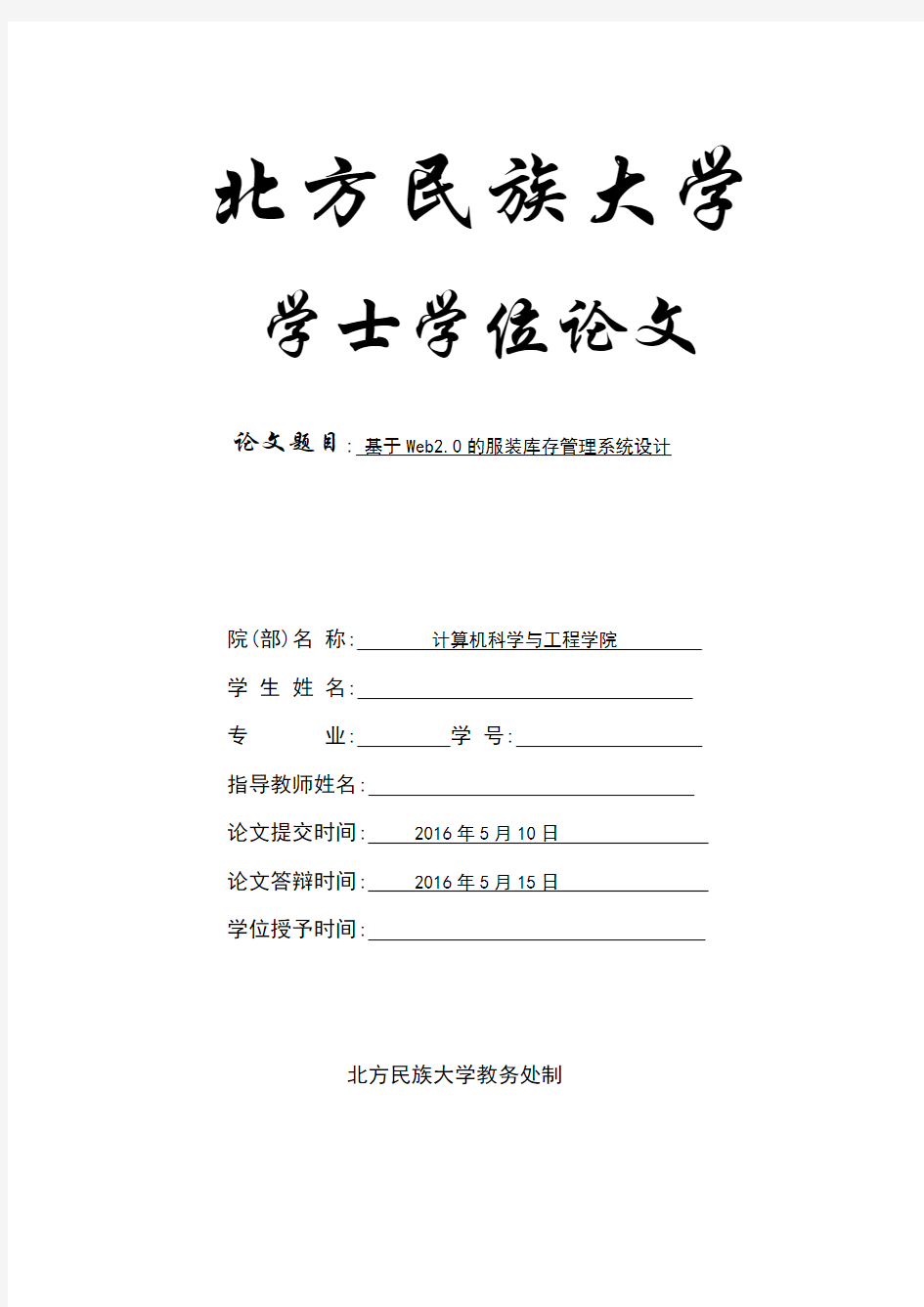计算机毕业设计-基于web2.0的服装库存系统

- 1、下载文档前请自行甄别文档内容的完整性,平台不提供额外的编辑、内容补充、找答案等附加服务。
- 2、"仅部分预览"的文档,不可在线预览部分如存在完整性等问题,可反馈申请退款(可完整预览的文档不适用该条件!)。
- 3、如文档侵犯您的权益,请联系客服反馈,我们会尽快为您处理(人工客服工作时间:9:00-18:30)。
北方民族大学学士学位论文
论文题目:基于Web2.0的服装库存管理系统设计
院(部)名称:计算机科学与工程学院
学生姓名:
专业:学号:
指导教师姓名:
论文提交时间: 2016年5月10日
论文答辩时间: 2016年5月15日
学位授予时间:
北方民族大学教务处制
基于Web2.0的服装库存管理系统设计
摘要
本系统是基于B/S的web系统,使用spingMVC使各层分离。前台页面部分使用了Jsp、css、easyUI、JavaScript、jquery等技术,开发过程中使用SSH 框架,使用这些技术主要是为了便于系统的后期维护。
服装库存系统的开发目的是改进当前手工管理方式,提高工作效率。基本数据管理可以将出入库的服装、仓库、客户信息进行管理,将出入库所涉及到的信息进行统一管理,避免了原本手工管理方式可能造成的错误信息录入。通过出入库单与出入库单明细操作,可以清晰了解每单具体过程信息,责任到个人,保证了工作的准确性与效率。
关键词:服装库存系统,SSH,B/S
Design of clothing inventory management system based
on Web2.0
Abstract
The system is based on the web of the B/S system, using spingMVC to make each layer of separation. The front page part of the use of Jsp, CSS, easyUI, JavaScript, jQuery and other technologies, the development process using the SSH framework, the use of these technologies is mainly in order to facilitate the late system maintenance.
The development goal of clothing inventory system is to improve the current manual management mode and improve the efficiency of the work. Management of basic data to the storage of clothing, warehouse, customer information management, will be out of storage involves information for unified management, to avoid the original manual management mode may cause the error information input. Through a single storage and warehousing single operation details, we can clearly understand each specific process information, the responsibility to the individual, to ensure the accuracy and efficiency of the work.
Key words: clothing inventory system, SSH, B/S
目录
第1章项目背景 (1)
1.1服装库存管理现状 (1)
1.1.1传统管理流程分析 (1)
1.1.2新型信息化方向分析 (1)
1.2选题的目的与意义 (1)
1.3本次课题的成果 (2)
第2章可行性研究与需求分析 (3)
2.1系统需求分析 (3)
2.2 可行性研究 (3)
2.2.1 技术可行性 (3)
2.2.2 资金可行性 (3)
2.2.3 操作可行性 (4)
2.2.4 法律可行性 (4)
2.3系统实现目标 (4)
2.4系统整体需求规定 (4)
2.4.1数据处理要求 (4)
2.4.2数据库能力要求 (4)
2.4.3故障处理要求 (4)
2.4.4运行环境要求 (5)
第3章开发技术与环境选择 (6)
3.1 J2EE概述 (6)
3.2 Hibernate框架概述 (6)
3.2.1 Hibernate简述 (7)
3.2.2 Hibernate的优点 (7)
3.3 Spring概述 (8)
3.4系统架构 (8)
第4章系统详细设计 (9)
4.1数据库设计 (9)
4.1.1 功能模块图 (9)
4.1.2 数据库表设计 (9)
4.2类设计 (11)
4.2.1 实体类 (11)
4.2.2 Action类 (11)
4.3界面设计 (17)
4.3.1 登录 (17)
4.3.2 主界面 (17)
4.3.3 基本数据管理 (17)
4.3.4入库管理 (20)
4.3.5出库管理 (21)
4.3.6库存管理 (22)
4.3.7系统管理 (23)
4.4项目代码层次结构 (25)
第5章系统的调试与测试 (27)
5.1测试目的 (27)
5.2功能测试及结果 (27)
总结 (29)
致谢 (30)
参考文献 (31)
